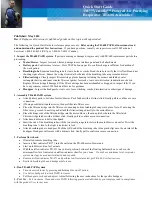
5
Crankcase Heater
The crankcase heater prevents refrigerant migration and
compressor oil dilution during shutdown when compressor is not
operating. If the crankcase heater is de--energized for more than 6
hours, both compressor service valves must be closed.
NOTE
:
Crankcase heaters are only factory--supplied on
538A030--060 units. Addition of an accessory crankcase heater is
required for long line and low ambient cooling applications on 018
and 024 size units. See Residental Long Line Guideline.
The crankcase heater is powered by the high--voltage power of the
unit. It is connected across the line side of the contactor and is
thermostatically controlled.
!
WARNING
PERSONAL INJURY HAZARD
Failure to follow this warning could result in personal injury
or death.
Use extreme caution when troubleshooting this device as line
voltage is continually present.
To troubleshoot:
1. Apply voltmeter across crankcase heater leads to see if heat-
er voltage is on. Do not touch heater. Carefully feel area
around crankcase heater; if warm, crankcase heater is func-
tioning.
2. With power off and heater leads disconnected, check across
leads with ohmmeter. Do not look for a specific resistance
reading. Check for resistance or an open circuit, and change
heater if an open circuit is detected.
Service Valves
The service valves in the outdoor unit come from the factory
frontseated. This means the refrigerant charge is isolated from the
line--set connection ports. To prevent damage to the valve, use a
wet cloth or other accepted heat sink material on the valve before
brazing.
The service valve cannot be field repaired, therefore, only a
complete valve or valve stem seal and service port caps are
available for replacement.
Refrigerant Charging
!
WARNING
PERSONAL
INJURY
AND/OR
EQUIPMENT
DAMAGE HAZARD
Failure to follow this warning could result in personal injury
and/or equipment damage.
Wear safety glasses and gloves when handling refrigerant.
Do not overcharge system -- this can cause compressor
flooding.
!
WARNING
PERSONAL
INJURY
AND/OR
EQUIPMENT
DAMAGE HAZARD
Failure to follow this warning could result in personal injury
and/or equipment damage.
Service valves must be fully backseated to close service
port. There is no Schrader valve at the service port, and
failure to backseat the valve could result in loss of system
charge or personal injury.
NOTE
:
Do not vent or de--pressurize unit refrigerant to
atmosphere. Remove and recover refrigerant following accepted
practices.
All units are shipped with the refrigerant charge listed on the
nameplate.
Refer to Product Data and consider the following when working
with Puron (R--410A) refrigerant:
S
Puron refrigerant cylinders are rose colored.
S
Recovery cylinder service pressure rating must be 400
psig, DOT (Department of Transportation) 4BA400 or
DOT BW400.
S
Puron systems should be charged with liquid refrigerant.
Use a commercial type metering device in the manifold
hose when charging into suction line with compressor op-
erating.
S
Manifold sets should be 700 psig high side and 180 psig
low side with 550 psig low--side retard.
S
Use hoses with 700 psig service pressure rating.
S
Puron refrigerant, as with other HFCs, is only compatible
with POE oils.
S
Vacuum pumps will not remove moisture from oil.
S
Polyol Ester oils absorb moisture rapidly. Do not expose oil
to atmosphere.
S
Polyol Ester oils may cause damage to certain plastics and
roofing materials.
S
Wrap all filter driers and service valves with wet cloth when
brazing.
S
factory approved, liquid--line filter drier is required on ev-
ery unit.
S
Do not use a TXV (thermostatic expansion valve) designed
for use with R--22 refrigerant. Refer to separate indoor unit
installation instructions for more details.
S
f using a suction line drier, do not leave in place for more
than 72 hours.
Check Charge
Factory charge amount and desired subcooling are shown on unit
rating plate. Charging method is shown on information plate inside
unit. To properly check or adjust charge, conditions must be
favorable for subcooling charging. Favorable conditions exist
when the outdoor temperature is between 70
_
F and 100
_
F (21
_
C
and 38
_
C), and the indoor temperature is between 70
_
F and 80
_
F
(21
_
C and 27
_
C). Follow the procedure below:
Unit is factory charged for 15 ft (4.6 m) of line--set. Adjust charge
by adding or removing 0.6 oz/ft of 3/8 liquid line above or below
15 ft (4.6 m) respectively.
For standard refrigerant line lengths (80 ft/24 m or less), allow
system to operate in cooling mode at least 15 minutes. If conditions
are favorable, check system charge by subcooling method. If any
adjustment is necessary, adjust charge slowly and allow system to
operate for 15 minutes to stabilize before declaring a properly
charged system.
If the indoor temperature is above 80
_
F (27
_
C), and the outdoor
temperature is in the favorable range, adjust system charge by
weight based on line length and allow the indoor temperature to
drop to 80
_
F (27
_
C) before attempting to check system charge by
subcooling method as described above.
If the indoor temperature is below 70
_
F (21
_
C), or the outdoor
temperature is not in the favorable range, adjust charge for line set
length above or below 15 ft (4.6 m) only. Charge level should then
be appropriate for the system to achieve rated capacity. The charge
level could then be checked at another time when the both indoor
and outdoor temperatures are in a more favorable range.
538A
























